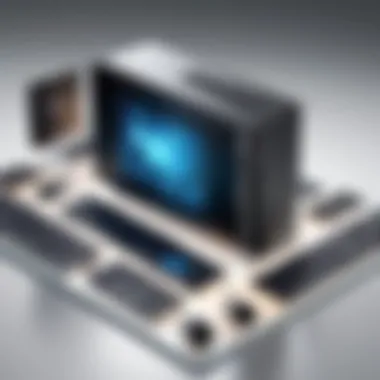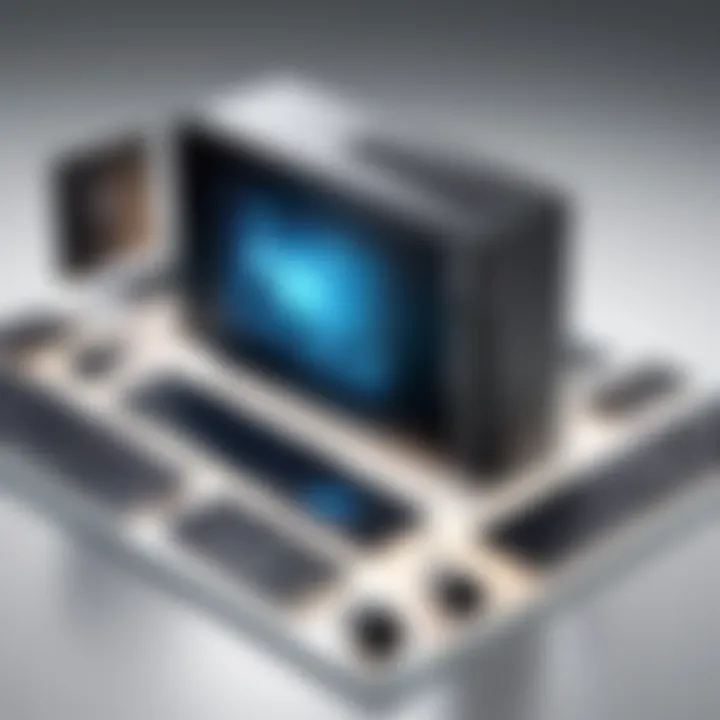Exploring Small Footprint Computers: Efficiency Meets Performance


Intro
In the ever-evolving landscape of technology, small footprint computers have carved out a unique niche. These systems embody a blend of compact design and robust performance, appealing to tech enthusiasts, gamers, and IT professionals alike. As we delve into this topic, we align ourselves with the pressing needs of modern computing environments where space is a premium.
Small footprint computers offer a range of configurations that reflect efficiency in both form and function. They find their vital role in a myriad of applications, from gaming setups in tight corners to workstations optimizing every inch of space. By looking closely at the benefits and challenges surrounding these systems, we can appreciate their transformative impact.
Product Overview
When we discuss small footprint computers, several noteworthy brands pop up. Each brand brings something different to the table, influencing customer choices through their unique specifications and features.
Brand Information
One standout example is Intel NUC. These mini-PCs are designed for versatility with a variety of configurations. Another popular option is Raspberry Pi, which, while perhaps more limited in raw power, shines in educational and DIY projects.
Key Specifications
- Intel NUC: 4 to 64GB RAM, Intel Core i3/i5/i7 processors, and support for NVMe storage.
- Raspberry Pi: ARM Cortex processors, 1 to 8GB RAM, and GPIO pins for connection with various devices.
Pricing
- Intel NUC: Ranges from approximately $300 to $1,000, depending on the specifications.
- Raspberry Pi: Typically around $35 to $75, depending on the model and accessories.
Performance Comparison
Performance benchmarks aid in demonstrating how these devices stack against one another. While speed is a crucial metric, efficiency often plays an equally significant role in user satisfaction.
Benchmark Tests
Intel NUC typically outperforms Raspberry Pi in areas requiring heavy computing, such as gaming or graphic design tasks. However, the Raspberry Pi shines in tasks where low power consumption is a priority.
Speed and Efficiency Comparisons
Intel NUC benchmarks report higher scores in multi-threaded performance, making them ideal for demanding applications.
Raspberry Pi, by contrast, excels in efficiency with minimal power consumption, making it a sensible choice for projects that need battery operation or run continuously.
Features and Technology
Small footprint computers are not just about being compact; they often incorporate cutting-edge technology that enhances usability.
Unique Features
- Intel NUC: Modular design for easy upgrades, integrated graphics for better visual output.
- Raspberry Pi: GPIO pins for connecting sensors and other electronic devices, which allows customization in various projects.
Technological Advancements
Recent iterations of these devices have introduced technology such as USB-C power delivery, Bluetooth connectivity, and Wi-Fi 4 or 5 capabilities that bridge compatibility with modern peripherals.
Compatibility with Other Devices
Both Intel NUC and Raspberry Pi offer broad compatibility. The NUC can run a wide range of operating systems, while the Raspberry Pi has extensive community support for various programming and usage scenarios.
Pros and Cons
Strengths of the Product
- Intel NUC: Powerful processing capability, excellent for creative work or gaming.
- Raspberry Pi: Inexpensive, low power, and highly customizable.
Areas for Improvement
- Intel NUC: Pricey compared to basic needs; requires additional components for optimal performance.
- Raspberry Pi: Limited processing power, not suitable for intensive tasks.
Value for Money
Determining the value of these small footprint systems requires a look into both upfront costs and long-term benefits.
Cost-effectiveness
When using Raspberry Pi for low-cost projects, it’s hard to beat its price point. The Intel NUC requires higher initial investment but pays off in performance.
Long-term Benefits
Investing in an Intel NUC can yield years of capability for users needing serious computing power. Conversely, a Raspberry Pi opens the door to endless DIY projects.
Comparison with Similar Products
Compared to larger desktop systems, both of these compact options offer significant savings without a huge sacrifice in performance, particularly if the task at hand doesn’t require top-tier hardware.
"Small footprint computers empower users to maximize their space and creativity, marrying efficiency with performance in today's tech landscape."
By weighing these elements together, it’s clear that small footprint computers represent a fascinating evolution in technology, where size is not synonymous with diminished capability. For tech enthusiasts, understanding these nuances can facilitate better purchasing decisions that align with their specific needs.
Understanding Small Footprint Computers


In today’s rapidly evolving tech landscape, small footprint computers have carved out a niche that balances performance with space constraints, leading not just to practical solutions but also to robust innovation. These devices, which pack substantial computing power into compact sizes, have become indispensable across a variety of applications.
Looking at offices where desk space is at a premium or small studios trying to maintain a tidy setup, these computers offer a tangible solution that doesn’t skimp on performance. Understanding small footprint computers means recognizing the marriage of efficiency and technological advancement. It invites us to explore how these devices can streamline workflows and even shapes new trends in various fields of technology.
Definition and Characteristics
Small footprint computers refer to devices designed to occupy minimal physical space while delivering capable computing functions. Characteristics that define these devices typically include:
- Compact Size: Generally, they are significantly smaller than traditional towers or desktops.
- Energy Efficiency: These devices consume less power, promoting sustainability in computing.
- Diverse Configurations: From mini PCs to single-board computers like Raspberry Pi, the options are varied.
This definition not only sets the groundwork for understanding their design but highlights their adaptability for various tasks—from media consumption to office productivity. Because they often come with integrated components, such as CPUs and memory, they can simplify setups while still maintaining functionality.
Importance in Today's Technology Landscape
The relevance of small footprint computers today can’t be overstated. As we advance toward more digital-centric lifestyles, these machines offer significant advantages. For instance:
- Rise of Remote Work: As workplaces transition to hybrid environments, the need for efficient yet portable systems continues to soar.
- Smart Home Integration: Many smart devices rely on compact computing power, serving functions that range from security monitoring to home entertainment.
- Cost-Effectiveness: These machines not only save space but often come at lower price points compared to their larger counterparts, making them accessible for more users.
The charming irony is clear; as the world pushes for greener tech solutions, small footprint computers step into the limelight. They align with sustainability goals, embodying a trend of doing more with less. In a landscape where every inch of space counts, a little device can make a big difference.
"Small footprint computers aren't just tools. They're catalysts of change in how we work and play in this small world."
Types of Small Footprint Computers
The world of compact computing has garnered significant attention in recent years. The rise of small footprint computers is not just a trend; it reflects a shift in how we perceive computer technology, particularly concerning space and efficiency. These machines are designed to pack a punch while taking up as little room as possible. Understanding the types of small footprint computers helps one appreciate the diverse applications available now and the potential for innovation in future technologies.
Mini PCs
Mini PCs have carved a niche for themselves for those seeking to balance performance and space. A classic example would be the Intel NUC, which is known for its powerful capabilities jammed into a tiny box. These devices often contain desktop-grade processors, memory options, and storage solutions, presenting a formidable alternative to traditional towers.
When considering a Mini PC, buyers should note their applicability across various scenarios—home entertainment, casual gaming, and even business use. With their compact form, they can easily fit into tight spaces, like a shelf or a corner of an office. Additionally, the energy efficiency of Mini PCs generally exceeds that of larger desktops, making them an attractive option for eco-conscious users as well.
NUCs (Next Unit of Computing)
Next on the list are NUCs, or Next Unit of Computing devices. Known for their sleek design and barebones configurations, NUCs are often favored by enthusiasts. One can select the components they wish to install, such as processors or RAM, which adds a layer of customization and embraces the DIY spirit.
These units have become increasingly popular in settings that require media-rich applications, like video editing or gaming, without taking up a significant amount of desk real estate. Their energy efficiency is commendable too, often allowing users to run high-performance tasks without seeing a massive spike in their energy bills. Like Mini PCs, NUCs are excellent for home offices or compact living spaces.
Thin Clients
Thin clients represent a different approach to small footprint computing. Unlike their more powerful counterparts, thin clients rely heavily on network resources, providing connectivity to external servers to handle the bulk of processing. A familiar example would be the Citrix Workspace Hub, which seamlessly integrates cloud applications and virtual desktops into a singular, compact unit.
These devices are secure and energy-efficient, making them ideal for businesses that prioritize security and centralized management. Employees can access their usual applications from any connected thin client, streamlining workflows and reducing costs related to hardware. However, one must be cautious; a heavy reliance on internet connectivity can lead to performance hiccups, especially in bandwidth-limited environments.
Raspberry Pi and Similar Boards
A Raspberry Pi is a game-changer in small footprint computing. This tiny yet mighty board can be utilized in countless ways: from a simple home server to controlling a smart garden. The community surrounding Raspberry Pi fosters creativity, making it a favorite among hobbyists and educators.
What stands out, though, is not just its affordability but also its versatility. You can connect sensors, lights, and many other peripherals, transforming your small footprint computer into practically anything you can imagine. Educational institutions often leverage Raspberry Pi for teaching programming and electronics in a hands-on manner, demonstrating the importance of fostering skills in a world increasingly focused on technology.
Overall, small footprint computers come in various shapes and forms, each offering distinct advantages and considerations. Whether one is looking for a powerful Mini PC to replace a traditional desktop or exploring a Raspberry Pi for a DIY project, there's no shortage of options in this versatile market.
Advantages of Small Footprint Computers
The growing reliance on compact computing devices can't be overstated. As technology progresses and the demand for efficiency sharpens, small footprint computers stand out for their array of benefits. Their unique design and functionality appeal to a wide audience, from tech enthusiasts to IT professionals. This section looks into why these diminutive systems merit attention, emphasizing their advantages in various contexts.
Space Efficiency
One of the primary advantages of small footprint computers is their space-saving nature. In an age where real estate, whether in homes or offices, has become increasingly precious, these compact machines fit seamlessly into tight spots. A mini PC or a NUC can snugly sit atop a desk or be tucked away beside a monitor without cluttering the workspace.
Their size has practical implications too. In busy environments like retail stores or hospitals, where space is at a premium, utilizing small footprint computers allows for efficient setup and maintenance. For example, an IT department can deploy numerous thin clients in a single small room, aiding in centralized management and reduced disarray. This not only enhances operational workflows but also fosters a tidier work environment that can boost productivity and morale.
Energy Consumption
Another compelling aspect is the dramatically reduced energy consumption. Small footprint computers tend to run on lower wattages compared to their bulky counterparts. Often, they consume less energy while delivering adequate performance for a variety of tasks. This factor is incredibly significant in today's eco-conscious society, where both businesses and individuals are seeking ways to reduce their carbon footprint and promote sustainability.
For instance, organizations switching from traditional desktops to mini PCs report noticeable decreases in electricity bills. Over time, the combined savings contribute to a more substantial budget that can be allocated elsewhere—whether it be for technology upgrades or staff training. Plus, in light of global concerns over climate change, using energy-efficient devices aligns well with sustainable practices that the public increasingly values.
Portability
Lastly, portability is yet another feather in the cap of small footprint computers. Imagine needing to shift your workstation from one room to another or perhaps even deliver your setup to a client meeting. This is where small computers shine brightly. Designed to be lightweight and easily transportable, they cater to the on-the-go lifestyle relevant to many professionals today.
Whether it’s a student taking a Raspberry Pi to a coding workshop or a businessperson utilizing a compact machine for presentations, the convenience of carrying all the necessary hardware in a backpack or underarm pouch cannot be overlooked. Users find it easier than ever to maintain productivity away from their primary setups. In an era that values flexibility, small footprint computers bridge the gap between robust functionality and easy transport.
"The right technology, when harnessed properly, can pave the way for unprecedented adaptability in our work and leisure environments."
In summary, the advantages of small footprint computers reduce the struggle of space limitations, amplify energy efficiency, and enhance portability for users across diverse sectors. As we continue to blend technology with our daily lives, understanding these benefits becomes crucial in making informed decisions about our computing needs.
Disadvantages and Limitations
When we think about small footprint computers, it’s easy to get caught up in their obvious benefits—space efficiency, low energy consumption, and impressive portability. However, a deeper examination reveals that these compact devices are not without their drawbacks. Understanding the limitations of small footprint computers is essential for making informed decisions, particularly for tech enthusiasts, gamers, and IT professionals who seek the best tools for their specific needs.
Performance Constraints


One of the most significant disadvantages of small footprint computers is their performance constraints. While they can handle everyday tasks effectively, they often struggle with resource-intensive applications. In particular, gaming and graphic design require substantial processing power and memory, which smaller systems may lack.
The compact design often leads to reduced processing capabilities. For instance, a mini PC may rely on integrated graphics rather than a dedicated graphics card, limiting its ability to run demanding games smoothly.
Moreover, thermal management becomes a challenge. With limited space for cooling systems, small footprint computers may experience overheating during heavy use. This can cause performance throttling, where the device reduces its processing speed to cool down, ultimately leading to frustrating user experiences. It's like trying to run a marathon in a snuggly pair of jeans—certainly not a recipe for success.
Upgrade Challenges
Another notable limitation lies in the upgrade challenges presented by small footprint computers. In traditional desktop systems, swapping out components like graphics cards or memory sticks is a relatively straightforward task. With compact systems, however, upgrading can often feel like trying to fit a square peg in a round hole.
Space constraints mean that many small footprint computers come with soldered components—like RAM and storage—making it impossible to upgrade these essential parts. Once you buy a system, its capacity may be fixed, limiting its life span as software demands increase.
Additionally, if an upgrade is possible, it might require specialized knowledge or tools. For example, an IT professional might face the headache of removing a shell and disconnecting delicate wires to upgrade a part. The time and effort involved can deter even the most tech-savvy individuals from attempting upgrades. Whether you're looking to boost RAM or change a hard drive, it can seem a daunting task, often leading users to think twice before investing in a small computer.
In summary, while small footprint computers can be incredibly appealing due to their compactness and resource efficiency, potential users must weigh these factors against the performance constraints and upgrade challenges they may face.
"Choosing the right computing solution means striking a balance between portability and capability."
Applications Across Industries
Small footprint computers make a significant splash across various industries, blending efficiency with performance in ways that traditional systems often can't match. These compact machines cater to specific needs, enabling businesses and individuals alike to maximize their resources while still achieving powerful computing capabilities. As technological advancements march forward, small footprint computers flex their muscle in home computing, business environments, education, and even gaming.
Home Computing
In the realm of home computing, small footprint computers shine by providing sleek and efficient alternatives to bulky desktops. Home users often require a balance of performance and space-saving designs, and small PCs fit the bill perfectly. Whether it’s streaming movies, browsing the web, or light gaming, these machines offer enough power to handle daily tasks without taking over the living room. The Raspberry Pi has especially found its niche, demonstrating how even a tiny board can perform various functions, from media centers to home automation systems.
- Space-Saving Design: Noone wants a cluttered workspace, and small footprint computers help maintain an organized atmosphere.
- Energy Efficiency: Household energy bills don’t need to skyrocket, thanks to the lower power consumption of these compact systems.
- Easy Setup: Users can often plug and play with minimal installation hassle, making technology more accessible to all.
Business Use Cases
In business environments, small footprint computers are increasingly viewed as viable solutions for daily operational tasks. For instance, companies outfitted with mini PCs in offices leverage the technology's versatility to run essential software without sacrificing desk space. Retailers can deploy thin clients at checkout counters, connecting to cloud services for smooth transactions. The notable Lenovo ThinkCentre M90n is an excellent example of a robust business solution that marries functionality with a low profile.
- Cost Efficiency: Many small footprint options are budget-friendly compared to traditional systems, allowing businesses to allocate funds elsewhere.
- Versatility: These machines can be configured to suit specific tasks, from data processing to handling multiple applications.
- Security: Enhanced security features in some models help protect sensitive information, which is paramount in any business.
Education and Learning Environments
Small computers play a pivotal role in educational settings, making technology accessible to students and teachers alike. Classrooms equipped with compact systems can not only conserve space but also enable a wide range of learning opportunities. Devices such as Chromeboxes serve as powerful tools for both student learning and administrative tasks. Furthermore, many educational institutions have adopted Raspberry Pi projects to teach coding and electronics, demonstrating the potential of smaller tech.
- Hands-On Learning: Compact systems often provide students with hands-on experience, fostering creativity and problem-solving skills.
- Collaboration: Easy-to-set-up devices allow for collaborative projects, promoting teamwork among students.
- Budget-Friendly: Schools can benefit from lower costs without compromising on technology needed for a modern educational curriculum.
Gaming
While one might think gaming necessitates robust setups with high-end specifications, many small footprint computers can indeed stand up against larger rigs. Mini PCs like the ASUS ROG Strix GA15 can run demanding games while being compact enough for limited spaces. Hardcore gamers appreciate the portability of these systems, allowing them to take their gaming sessions anywhere from LAN parties to gaming cafés.
- Portability: Gamers can easily transport their systems for multiplayer events, without lugging around heavy towers.
- Space Optimization: Compact setups can fit perfectly in tight spaces, changing how gaming setups are designed.
- Customization: Many small footprint systems still allow for upgrades, ensuring gamers can enhance their equipment over time.
Small footprint computers are revolutionizing how we approach technology across multiple sectors. Their adaptability frees users from constraints, paving the way for a future where efficient computing is the norm.
Comparison with Traditional Desktop Computers
In the current digital landscape, the discussion around small footprint computers often circles back to their comparison with traditional desktop systems. Understanding these differences is pivotal for tech enthusiasts, gamers, and IT professionals who need to evaluate what fits their requirements best. This section delves into the cost considerations and performance metrics of both types of machines, shedding light on why one might opt for a compact solution over a conventional setup.
Cost Analysis
When it comes to budgeting for a computing solution, price is a considerable factor. On many occasions, small footprint computers can offer a more palatable price point compared to their traditional desktop counterparts. For instance, Mini PCs, like the Intel NUC, often start at a significantly lower baseline price, which allows users to allocate funds effectively toward other critical accessories or peripherals.
In contrast, traditional desktops could require a heftier investment right off the bat, especially when factoring in the costs of larger form factors, monitors, and additional hardware components. However, it’s essential to weigh not just the upfront cost but also the long-term value.
"In many cases, small footprint designs leverage new manufacturing techniques that allow for reduced costs without skimping on quality."
Having said that, buyers should evaluate the total cost of ownership. While a compact computer might save cash upfront, one must consider the longevity and upgradeability of the device. Traditional desktops tend to have easier pathways for upgrades. Here are some specific costs to ponder on:
- Initial Purchase Price: Typically, small footprint machines are cheaper initially.
- Upgrades: Desktop PCs might entail higher costs down the line for upgrades due to their modular nature.
- Specialized Components: Small footprint computers sometimes require proprietary components, which could drive up costs unpredictably.
Performance Metrics
While costs often drive initial decisions, performance can't be neglected. Small footprint computers hold their own in specific tasks, but traditional desktops still reign supreme in raw performance metrics.
Small footprint computers usually come equipped with energy-efficient processors. For light tasks like browsing and productivity applications, these machines perform excellently without breaking a sweat. However, when it comes to intensive tasks such as gaming or video rendering, traditional desktops equipped with higher-end GPUs and CPUs have the edge.
Some critical benchmarks to observe include:
- Processing Power: Desktop systems often utilize more powerful CPUs that can handle multitasking better than their compact counterparts.
- Memory and Storage: While small footprint computers might suffice for day-to-day tasks, they often come with limited RAM and storage options. Traditional desktops allow for ample customization.
- Gaming Performance: Gamers, especially, will find that traditional desktops often comfortably support more demanding games due to superior graphics capabilities.
Key Components of Small Footprint Computers
When we talk about small footprint computers, it's not just about their size; it's also about the intricate components that make them tick. Understanding these key elements is crucial, especially for tech enthusiasts, gamers, and IT professionals who want to maximize efficiency and performance while dabbling in compact computing. Each component plays a vital role in ensuring these systems not only fit snugly on a desk or in a bag, but also deliver the power needed for a variety of tasks.
Processors
The processor is often dubbed the brain of any computing system. In small footprint computers, this component is crucial. Manufacturers often opt for energy-efficient processors that strike a fine balance between performance and thermal output. For instance, Intel's Core i5 series in a NUC device exemplifies this balance, offering robust performance in a compact design.
The integration of multi-core processors allows these machines to handle multitasking effectively. However, smaller devices sometimes use processors that have lower clock speeds or fewer cores compared to traditional desktops. Choosing the right processor depends on your intended use. If you're gaming or doing video editing, you want that extra power. If it's for basic tasks like web browsing, a lower-end processor could suffice.


Storage Solutions
Storage can make or break a small footprint computer. Typically, these systems rely on solid-state drives (SSDs) instead of traditional hard disk drives (HDDs). The reason? SSDs are smaller, faster, and consume less power. They significantly enhance the system's responsiveness, leading to improved boot times and application load speeds.
Consider this: a 1TB SSD can fit into a machine the size of a large paperback book, while offering enough room to store a considerable number of applications, games, and files. However, it’s essential to weigh the pros and cons of storage capacity versus speed. For those who prioritize sheer speed and reliability, investing in higher-capacity SSDs or hybrid solutions—SSD + HDD—is key to optimizing performance.
Connectivity Options
In today's interconnected world, having robust connectivity options is non-negotiable, especially for small footprint computers. These devices typically pack a range of ports that are vital for both personal and professional use. USB-C ports, HDMI outputs, and Wi-Fi 6 support are increasingly standard, providing seamless integration with peripherals and networks.
Moreover, Bluetooth capabilities are more than a luxury; they cater to wireless peripherals, such as keyboards and mice. It’s a vital component for anyone looking to declutter their workspace. Also, keep an eye on the upcoming trends in connectivity, as faster, more reliable technology continues to emerge.
"A small footprint computer isn't just a gadget; it's a sophisticated blend of technology that redefines what we consider possible in compact computing."
In summary, the core components of small footprint computers—processors, storage solutions, and connectivity options—play a pivotal role in determining how effectively these machines can perform their tasks. By understanding their importance, users can make informed choices that align with their specific needs, ensuring they find the right balance between size and capability.
Factors to Consider When Choosing a Small Footprint Computer
When it comes to selecting a small footprint computer, understanding the nuances is key. In today's fast-paced technological landscape, where systems are required to be both space-efficient and powerful, making an informed choice has never been more crucial. This section will guide you through the essential factors that influence your decision, so you end up with a computer that aligns perfectly with your needs.
Intended Use and Performance Requirements
The first step in determining the right small footprint computer is to assess its intended use. Are you looking to use this machine for day-to-day tasks like web browsing and document editing? Or do you need something more robust for gaming, video editing, or software development?
Understanding the performance requirements is the bedrock of your decision-making process. Small footprint computers can vary greatly in terms of processing power. For example, options like the Intel NUC series might be capable of handling demanding tasks thanks to their high-performance processors, while a basic Raspberry Pi might only suffice for simple automation projects.
Here are some specific elements to consider:
- Processor Capability: Check if the CPU is sufficient for your workload. Gaming and graphic design often require more powerful CPUs.
- RAM Capacity: More RAM means better multitasking, especially important for heavy applications.
- Graphics Requirements: If your work involves graphic design or gaming, look for a unit equipped with a dedicated GPU.
- Storage Type: SSDs are faster and more reliable compared to traditional HDDs, enhancing overall performance.
Ultimately, aligning your computer choice with your intended use will yield a device that performs smoothly and efficiently.
Budget and Cost-Benefit Analysis
Next up is the budget, which plays a pivotal role in your purchase decision. Small footprint computers can range from quite affordable to high-end models that come with a price tag that makes you do a double-take. Thus, carrying out a proper cost-benefit analysis before making your purchase is vital.
Consider these factors:
- Initial Purchase Price: What you're willing to spend can narrow down your options.
- Long-Term Reliability: Sometimes, spending a bit more upfront for quality components pays off in longevity and fewer repairs down the line.
- Energy Efficiency: Smaller systems often consume less energy, which can lead to cost savings over time.
- Upgrade Potential: A machine's ability to adapt to your needs is key. A budget model that cannot be upgraded may cost more in the long run if you need to replace it quickly.
Don't forget to compare prices across different platforms. Websites like Reddit can also provide insights from actual users, which can be invaluable when weighing your options.
"Choosing a small footprint computer isn't just about what's trendy; it's about what fits your needs and your pocket in the long run."
In short, understanding your performance needs and being realistic about your budget will lead to a well-rounded decision that provides both efficiency and performance in your small footprint computing experience.
Future Trends in Small Footprint Computing
In the fast-paced world of technology, small footprint computers are becoming an integral part of our daily lives. These compact machines not only cater to the need for efficiency but are also paving the way for innovations that will shape the future of computing. Understanding future trends within this domain is critical for tech enthusiasts, gamers, and IT professionals alike, as it influences how we interact with technology now and in years to come.
It’s helpful to look at a few specific elements that indicate where this area is headed:
Emerging Technologies
With the ongoing evolution in computing power and miniaturization, emerging technologies are at the forefront of small footprint computing. Innovations like advanced processors, such as ARM and RISC-V, are gaining traction due to their low power consumption while delivering impressive performance. These types of processors are particularly favorable for mini PCs and other compact systems, making them a great option for mobile computing.
Moreover, the rise of edge computing is also significantly impacting small footprint devices. By processing data closer to the source, edge computing minimizes latency and bandwidth issues, enhancing the performance of devices that require quick decision-making capabilities in real-time. For example, IoT devices paired with small footprint computers can excel in smart home technology, automating tasks while reducing energy costs.
Another area of interest is the integration of artificial intelligence into these compact systems. Imagine small footprint computers seamlessly running AI algorithms for home automation or gaming applications. This capability allows for enhanced personal experiences, providing users with instant and tailored feedback based on their preferences.
Sustainability Considerations
Sustainability is not just a buzzword; it’s a pressing concern that shapes consumer choices and industry standards. As the world moves towards greener technology, small footprint computers play a significant role in reducing environmental impact. Their inherent design promotes lower energy consumption, which not only translates to lower power bills but also contributes to a decrease in carbon footprints.
Furthermore, many manufacturers are embracing eco-friendly materials for their products. This includes recyclable parts or packaging that aligns with global sustainability goals. Consumers are becoming increasingly mindful of the lifecycle of their devices; hence, companies producing small footprint computers that emphasize longevity and recyclability are likely to gain a competitive edge.
The push towards sustainability also leads to innovations like energy-efficient cooling systems and smart power management features. These capabilities enhance the lifespan of devices while reducing energy waste.
"Small footprint computing is not merely about creating compact machines; it’s about imagining a future where technology and sustainability go hand-in-hand."
In summary, the future trends in small footprint computing show great promise for efficiency, innovation, and sustainability. Keeping tabs on these developments will not only benefit tech enthusiasts but will also set a foundation for more environmentally-conscious computing solutions. As these trends further unfold, they will undoubtedly influence hardware and software developments across industries.
Ending: The Evolving Role of Small Footprint Computers
As technology continues its relentless march toward efficiency and portability, the role of small footprint computers becomes increasingly pivotal in our digital lives. These compact machines, designed to maximize both space and functionality, can no longer be dismissed as mere novelties; they represent a significant shift in how we perceive computing. From the bustling offices of startups to cozy home workstations, the demand for smaller yet powerful computing solutions is skyrocketing.
Summary of Key Points
Throughout this article, we've dived into various aspects of small footprint computers, highlighting their importance and versatility. Here are some of the essential takeaways:
- Innovation in Design: The creativity involved in designing small footprint computers has resulted in diverse models, ranging from Mini PCs to Raspberry Pi units, each catering to different user needs.
- Efficiency at its Core: Small footprint computers excel in energy consumption and space efficiency, making them an appealing choice for both environmentally conscious users and those limited by physical space.
- Performance vs. Portability: While some may argue that small systems compromise performance, advances in technology have shown that these devices often deliver impressive processing power.
Additionally, they can thrive in different environments—be it for gaming, education, or enterprise applications.
"Small footprint computers are not just about saving space; they are about crafting a more efficient future."
Final Thoughts
The future of computing is evolving, and small footprint computers are at the forefront of this transformation. They embody a shift toward minimalism without sacrificing capability. As more users become aware of their many advantages, we are likely to see even greater innovation in this field. The potential for integrations with emerging technologies—like AI and IoT—further enhances their relevance and utility in diverse applications.
Moreover, considerations for sustainability will shape future designs and functionalities. As we navigate this rapid change, exploring the practical insights shared in this discussion will be invaluable for tech enthusiasts, gamers, and IT professionals alike. Embracing this shift not only improves personal computing experiences but also contributes to a larger movement towards resource efficiency in technology.







